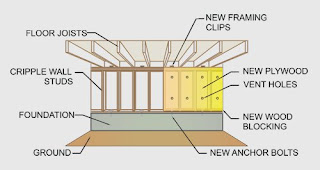 |
| Foundation |
Although those owners have probably all been selected by now, basic retrofits are not costly overall and can be done by following the idea in the illustrations. By doing simple bolting and bracing, a lot of damage can be prevented and may even cost less than $3000 depending on who performs the work or the construction issues of the foundation and walls. Cripple walls are not present in all homes, but if they are, and the house is not bolted to the foundation (pre-1933 homes were not required to be), then a retrofit ought to be of special interest.
 |
| Crawl Space view |
Since Long Beach is a larger city than Pasadena, and was developed in the same eras, it seems quite an oversight that it was not included in this program.
Earthquake Brace and Bolt, site for the California Residential Mitigation Program, explains more, and also provides FAQs and a search engine for licensed contractors.
Why should this be of so much importance? "California has two-thirds of the nation's earthquake risk. Some 2,000 known faults crisscross the state, producing an average of 102 earthquakes a day – more than 37,000 a year. Certain structures that lack adequate bolting and bracing are more vulnerable to earthquake damage. Older houses are often not bolted to their foundations and lack bracing on the wood framed exterior walls enclosing the crawl space. Houses without adequate bolting and bracing are prone to sliding or toppling off their foundation during an earthquake. This type of serious damage can be prevented with proper seismic retrofit of the crawl space."
What can you expect if you buy a pre-1933 home in Southern California? You may very well find that no retrofit has been done, and it's not something that is ordinarily asked of the seller during escrow because it's not a "repair". Such work is usually up to the new owner of the property, and is well worth the expense. Why didn't the previous owner do that work? That's the topic of another post.
See http://www.latimes.com/local/lanow/la-me-ln-quake-retrofit-grants-expanding-to-more-california-single-family-homes-20151118-story.html

No comments:
Post a Comment